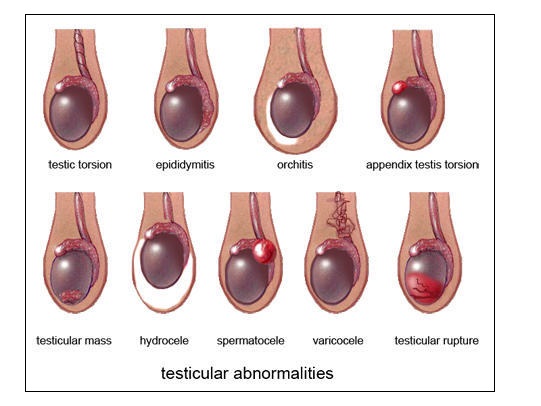
Testicular cancer is cancer that develops in the testicles, a part of the male reproductive system. The main function of the testes is to produce male sex hormones (testosterone) and sperm. Testicular cancer can invade one or both testicles.
Globally testicular cancer affected about 686,000 people in 2015. That year it resulted in 9,400 deaths up from 7,000 deaths in 1990. Rates are lower in the developing than the developed world.
Cancer of the testicle is 1 of the less common cancers, and tends to mostly affect men between 15 and 49 years of age.
The first sign of testicular cancer often is a bump or lump on a testicle. The cancer cells can grow quickly. They often spread outside the testicle to other parts of the body.
Testicular cancer is highly treatable, even when it spreads to other parts of the body. Treatments depend on the type of testicular cancer that you have and how far it has spread. Common treatments include surgery and chemotherapy.
Typically, a physical examination, blood tests, and imaging tests like an ultrasound, CT scan, or MRI are used to diagnose testicular cancer. A biopsy may be carried out to confirm the diagnosis if a lump is seen. The cancer's stage will be established if the diagnosis is certain. This is significant because the prognosis and available treatments will depend on the cancer's stage.
When testicular cancer is detected early, the prognosis is generally favorable. Men with localized testicular cancer have a five-year survival rate of more than 99%. Localized cancer indicates that it has not spread beyond the testicle. Even if the cancer has spread to neighboring lymph nodes, the five-year survival percentage remains high. This is due to the fact that testicular cancer is extremely treatable, and even advanced cases can often be treated with a combination of surgery, chemotherapy, and radiation therapy.
Surgery to remove the afflicted testicle is the most common treatment for testicular cancer. The entire testicle is removed through a groin incision in this operation. The surviving testicle is still capable of producing enough testosterone and sperm to support normal male function. To retain the appearance of the scrotum after surgery, the patient may have a prosthetic testicle implanted. If the malignancy has progressed to neighboring lymph nodes, removal of those nodes may also be required.
Chemotherapy is often used after surgery to kill any remaining cancer cells. Chemotherapy involves the use of drugs that target rapidly dividing cells, such as cancer cells. The drugs are usually given in cycles, with a period of treatment followed by a period of rest to allow the body to recover. Chemotherapy can cause side effects such as fatigue, nausea, and hair loss.
The 5-year survival rate tells what percent of people live at least 5 years after the cancer is found. The general 5-year survival rate for people with testicular cancer in the United States is 95%. This means that 95 out of every 100 people diagnosed with testicular cancer will live at least 5 years after diagnosis.
The survival rate is higher for people diagnosed with early-stage cancer and lower for those with later-stage cancer. For testicular cancer that has not spread beyond the testicles, the survival rate is 99%. Approximately 68% of cases are diagnosed at this stage.
So early diagnosis and treatment of testicular cancer can significantly improve the outcome and increase the chances of survival.


